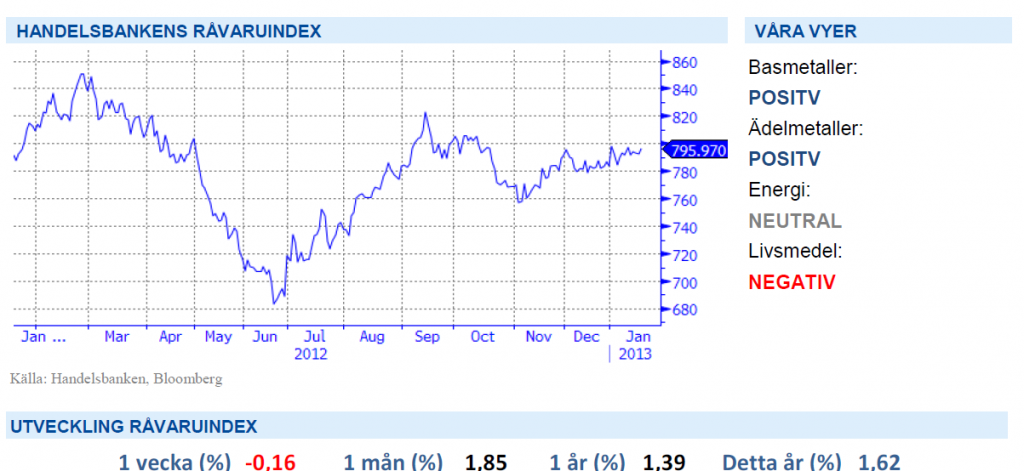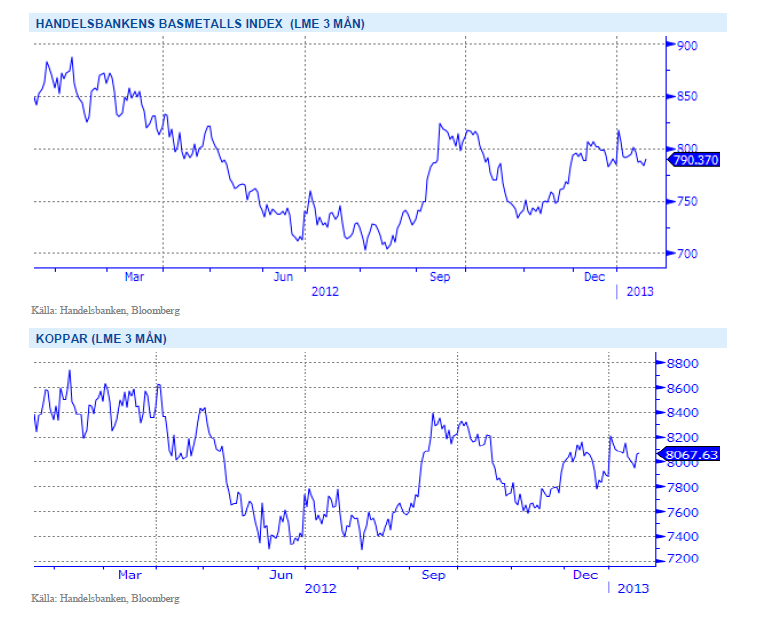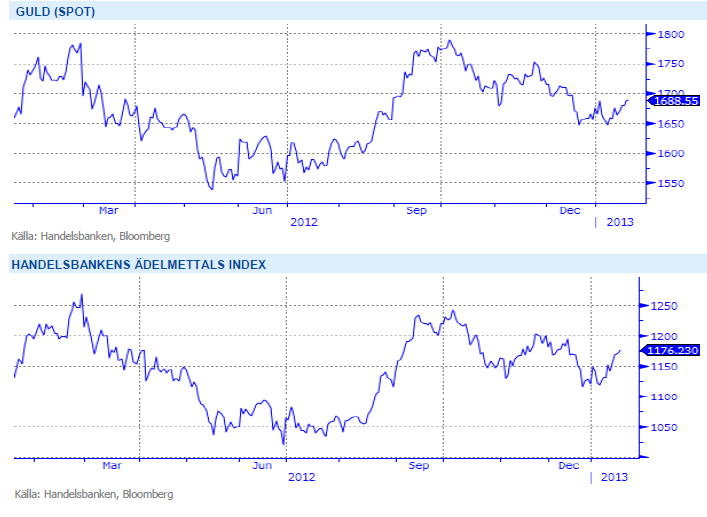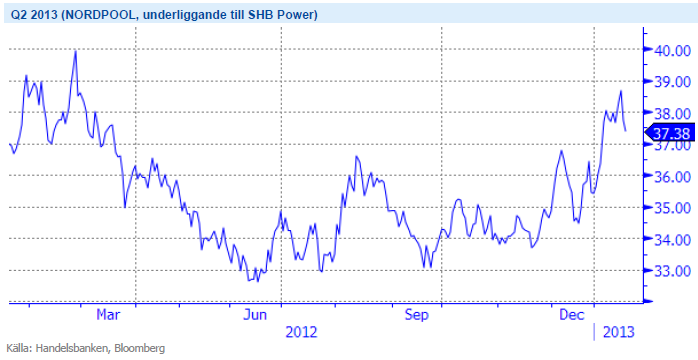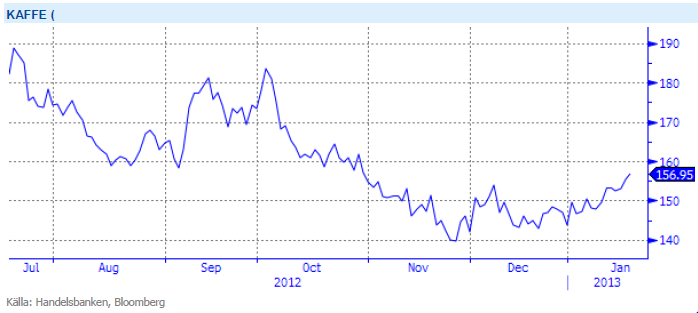Analys
SHB Råvarubrevet 18 januari 2013
 Allt fokus på USA
Allt fokus på USA
Vi håller fast vid en i grunden positiv syn på global makro i början på året, framförallt relaterat till Kina och USA. Synen på stigande riskaptit globalt ligger fast även om amerikansk politik kan hålla tillbaka något. Välkomna tecken på förbättringar i Kina kom denna vecka i form av BNP tillväxt för sista kvartalet på 7,9 %, upp från 7,4 % i Q3. Allt pekar nu på att botten i den kinesiska konjunkturcykeln var i september och att återhämtningen sprider sig.
Amerikanska konsumenter möter däremot stramare finanspolitik 2013. Förbättrade bo-, aktie- och arbetsmarknader ger dock framtidshopp. Aktiviteten inom industrin ser svagare ut än förväntat i inledningen på året trots att viss finanspolitisk osäkerhet skingrats. Risk finns att stundande finanspolitiska förhandlingar håller tillbaka aktiviteten fram till sista februari. Om inga nya överenskommelser kommer till stånd kommer skuldtaket slås vid mitten av februari eller något därefter, automatiska nedskärningar (0.5% av BNP) stundar den första mars, och den 27:e mars tvingas staten att stänga ned icke-essentiella områden
Basmetallerna
Lagerpåfyllnad och Kinas återhämtning i fokus
Kinas återhämtning har givit stöd åt metallmarknaden under hösten där man successivt byggt upp lager som betats av tidigare under året. Vi förväntar oss att uppgången fortsätter under första kvartalet även om ett skuldtyngt Europa samt diskussionerna kring USA’s skuldtak begränsar uppgången något. Blandade rörelser där nickel och koppar visat mest styrka och stigit med 3,4 respektive 1,94 %. Zink och aluminium har däremot tappat 2,5 % respektive 0,8 %.
Uppgången på koppar kom av sig och kontraktet handlades på 2-veckors lägsta efter att Barack Obama gick ut och varnade om en ekonomisk katastrof ifall kongressen misslyckas med att öka landets upplåningsgräns, men har nu återhämtat sig efter positiva försäljningssiffror från USA. Vi håller koppar som vår favorit bland basmetallerna, men ser positivt på hela sektorn under det kommande kvartalet
Med Kinas återhämtning i ryggen tror vi på stigande priser på basmetaller. Vi tror på: BASMET H
Ädelmetaller
Låga räntor stödjer ädelmetallerna
2012 avslutades med ganska stora prisrörelser för ädelmetaller, de avslutande veckorna förra året såg guldet falla med 4 procent, och silvret med hela 10 procent. Dessa fall har i stort sett återhämtats under inledningen av 2013, och vi håller kvar vid vår positiva syn. Dock är vi lite mindre övertygade för tillfället, och vi anser att man bör vara observant på utvecklingen de närmaste veckorna.
De underliggande orsakerna till vår positiva syn är alltjämt de extremt låga räntorna världen över, och den risk vi ser för stigande inflationsförväntningar framöver. Låga räntor gör ju som bekant att alternativkostnaden för att hålla guld blir låg, och sjunkande korta räntor har historiskt varit nära länkat till stigande guldpris. Samtidigt så har guldet visat sig vara ett mycket bra skydd mot inflation, och en tillgång som tenderat att fungera bra när det varit kriser och finansiell oro i världen.
Det vi ser nu när vi går in i 2013 är begynnande optimism om både återhämtning i Kina och USA, och möjligheter till en överenskommelse under februari när det gäller den amerikanska budgeten. Detta kan leda till viss kortsiktig press nedåt på guldpriset, så vi känner att det är bra att ”dansa nära nödutgången” när det gäller långa guldpositioner. Men – skulle Obama och republikanerna inte nå en överenskommelse, då kommer guldet sannolikt vara en vinnare.
Inför 2013 är vi fortsatt positiva till ädelmetaller. Fortsatt mjuk penningpolitik, svag makroekonomi, starkare efterfrågan från Kina och Indien och att centralbanker i utvecklingsekonomier köper guld gör att vi tror på: ADELMET H
Energi
Svagt för både el och utsläppsrätter
Sentimentet fortsätter ned på elmarknaden där kontraktet Q2 2013 faller med över 2 procent. En tillfällig prisuppgång efter att Ringhals tillfälligt fallit ur. Såväl energikol (-3 % i år) som utsläppsrätter (-22% i år!) faller och de låga elpriserna på kontinenten bidrar till det svaga sentimentet på nordiska el. Det enda som givit stöd är en försvagad energibalans om 3 TWh ned till -16TWh (blått i grafen nedan) men prognoserna slår nu om från högtrycksbetonat väder till normala temperaturer och nederbörd för perioden så de flesta faktorer pekar ned. Kontraktet Q2 13 bör kunna falla ytterligare någon euro eller två. Intressant att se huruvida EU Kommissionen väljer att agera för att upprätta förtroendet för CO2-marknaden, annars finns det stor risk att rätterna faller tillbaka mot 0 nivån precis som de gjorde 2007.
Oljan har nu handlats i intervallet 105-117 USD sedan augusti förra året, och frågan är nu om detta mönster kommer fortsätta även under detta år. Vi ser ett antal risker som har god potential att föra oljan ut ur kanalen de kommande 6 månaderna. Tillsvidare håller vi neutral syn på oljan då ingen sida väger tyngre än den andra i nuläget. Det som talar för stigande priser är en starkare global konjunktur där vi har Kina i spetsen. Vidare har Saudiarabien, som lovat kompensera för Irans produktionsbortfall, den senaste tiden sänkt produktionen för att stabilisera priset när den globala konjunkturen blivit sämre under 2012. Även fortsatt politisk risk i Mellanöstern med risk för produktionsstörningar talar för ett högre pris. Samtidigt finns risk på nedsidan om Irans blockerade export kommer tillbaka till marknaden, den stigande produktionen i USA och Kanada och konjunkturrisker i USA och Europa. OECD-lagren är dessutom på femårs högsta.
Fallande priser på energikol och utsläppsrätter parat med låga elpriser på kontinenten bidrar till det svaga sentimentet på nordisk el. Vi tror på: BEAR EL H
Livsmedel
Kaffepriset stiger från de rekordlåga nivåerna
Kaffepriset har under en fem års period varit uppe och nosat på nivåer kring 3 dollar/Ib men handlas idag till det halverade priset. Rekordskördar i de kaffeproducerande länderna, Brasilien och Vietnam fick kaffepriset att falla 37 procent under 2012 och därmed var kaffe den råvara som backade mest under året som gått. Det har rapporterats om svampsjukdomar som spridits bland kaffeträd och dess blad, det råder därför en viss oro att dessa förstörelser kan komma att påverka nästa års skörd i Centralamerika. Detta har fått priset på Arabica terminen (underliggande till SHB Coffee) att stiga ca 8 procent sen årsskiftet.
Priset på vete har stigit under veckan och uppgången är till stor del påverkad av USDA:s rapport från förra fredagen där lagernivåer vad mindre än för väntat. Viss oro över situationen i USA där höstvetet bland annat behöver mer regn innan vintervilan är över, än finns det dock tid och oron är ganska begränsad. Effekten av förra veckans WASDE-rapport är nu över och det kommer krävas mer negativa nyheter för att priserna ska stiga ytterligare. Grödorna närmar sig dock ett känsligt utvecklingsstadium i flera viktiga spannmålsregioner och så länge risken för väderproblem inte känns mindre överhängande väntar vi oss en marknad som får ganska svårt att gå nedåt. Givet inga större väderproblem bör vi dock vänta oss fallande priser lite längre fram på året, veteproduktionen 2013 beräknas nå klart större volymer än 2012, en del prognoser pekar t.ex. på en drygt 8-procentig uppgång för den europeiska veteproduktionen.
Vi ser fortfarande framför oss fallande priser på livsmedelsektor på lite längre sikt. Vi tror på: LIVSMEDEL S H
Handelsbankens Råvaruindex
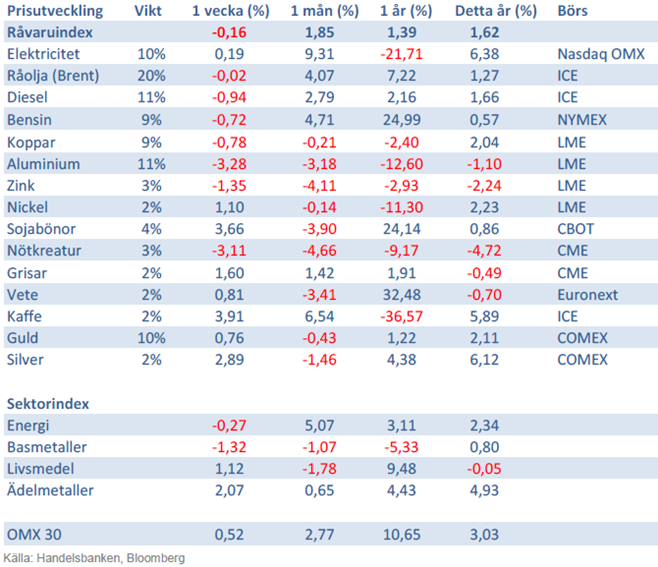
Handelsbankens råvaruindex består av de underliggande indexen för respektive råvara. Vikterna är bestämda till hälften från värdet av global produktion och till hälften från likviditeten i terminskontrakten.
[box]SHB Råvarubrevet är producerat av Handelsbanken och publiceras i samarbete och med tillstånd på Råvarumarknaden.se[/box]
Ansvarsbegränsning
Detta material är producerat av Svenska Handelsbanken AB (publ) i fortsättningen kallad Handelsbanken. De som arbetar med innehållet är inte analytiker och materialet är inte oberoende investeringsanalys. Innehållet är uteslutande avsett för kunder i Sverige. Syftet är att ge en allmän information till Handelsbankens kunder och utgör inte ett personligt investeringsråd eller en personlig rekommendation. Informationen ska inte ensamt utgöra underlag för investeringsbeslut. Kunder bör inhämta råd från sina rådgivare och basera sina investeringsbeslut utifrån egen erfarenhet.
Informationen i materialet kan ändras och också avvika från de åsikter som uttrycks i oberoende investeringsanalyser från Handelsbanken. Informationen grundar sig på allmänt tillgänglig information och är hämtad från källor som bedöms som tillförlitliga, men riktigheten kan inte garanteras och informationen kan vara ofullständig eller nedkortad. Ingen del av förslaget får reproduceras eller distribueras till någon annan person utan att Handelsbanken dessförinnan lämnat sitt skriftliga medgivande. Handelsbanken ansvarar inte för att materialet används på ett sätt som strider mot förbudet mot vidarebefordran eller offentliggörs i strid med bankens regler.
Analys
Tightening fundamentals – bullish inventories from DOE

The latest weekly report from the US DOE showed a substantial drawdown across key petroleum categories, adding more upside potential to the fundamental picture.

Commercial crude inventories (excl. SPR) fell by 5.8 million barrels, bringing total inventories down to 415.1 million barrels. Now sitting 11% below the five-year seasonal norm and placed in the lowest 2015-2022 range (see picture below).
Product inventories also tightened further last week. Gasoline inventories declined by 2.1 million barrels, with reductions seen in both finished gasoline and blending components. Current gasoline levels are about 3% below the five-year average for this time of year.
Among products, the most notable move came in diesel, where inventories dropped by almost 4.1 million barrels, deepening the deficit to around 20% below seasonal norms – continuing to underscore the persistent supply tightness in diesel markets.
The only area of inventory growth was in propane/propylene, which posted a significant 5.1-million-barrel build and now stands 9% above the five-year average.
Total commercial petroleum inventories (crude plus refined products) declined by 4.2 million barrels on the week, reinforcing the overall tightening of US crude and products.


Analys
Bombs to ”ceasefire” in hours – Brent below $70

A classic case of “buy the rumor, sell the news” played out in oil markets, as Brent crude has dropped sharply – down nearly USD 10 per barrel since yesterday evening – following Iran’s retaliatory strike on a U.S. air base in Qatar. The immediate reaction was: “That was it?” The strike followed a carefully calibrated, non-escalatory playbook, avoiding direct threats to energy infrastructure or disruption of shipping through the Strait of Hormuz – thus calming worst-case fears.

After Monday morning’s sharp spike to USD 81.4 per barrel, triggered by the U.S. bombing of Iranian nuclear facilities, oil prices drifted sideways in anticipation of a potential Iranian response. That response came with advance warning and caused limited physical damage. Early this morning, both the U.S. President and Iranian state media announced a ceasefire, effectively placing a lid on the immediate conflict risk – at least for now.
As a result, Brent crude has now fallen by a total of USD 12 from Monday’s peak, currently trading around USD 69 per barrel.
Looking beyond geopolitics, the market will now shift its focus to the upcoming OPEC+ meeting in early July. Saudi Arabia’s decision to increase output earlier this year – despite falling prices – has drawn renewed attention considering recent developments. Some suggest this was a response to U.S. pressure to offset potential Iranian supply losses.
However, consensus is that the move was driven more by internal OPEC+ dynamics. After years of curbing production to support prices, Riyadh had grown frustrated with quota-busting by several members (notably Kazakhstan). With Saudi Arabia cutting up to 2 million barrels per day – roughly 2% of global supply – returns were diminishing, and the risk of losing market share was rising. The production increase is widely seen as an effort to reassert leadership and restore discipline within the group.
That said, the FT recently stated that, the Saudis remain wary of past missteps. In 2018, Riyadh ramped up output at Trump’s request ahead of Iran sanctions, only to see prices collapse when the U.S. granted broad waivers – triggering oversupply. Officials have reportedly made it clear they don’t intend to repeat that mistake.
The recent visit by President Trump to Saudi Arabia, which included agreements on AI, defense, and nuclear cooperation, suggests a broader strategic alignment. This has fueled speculation about a quiet “pump-for-politics” deal behind recent production moves.
Looking ahead, oil prices have now retraced the entire rally sparked by the June 13 Israel–Iran escalation. This retreat provides more political and policy space for both the U.S. and Saudi Arabia. Specifically, it makes it easier for Riyadh to scale back its three recent production hikes of 411,000 barrels each, potentially returning to more moderate increases of 137,000 barrels for August and September.
In short: with no major loss of Iranian supply to the market, OPEC+ – led by Saudi Arabia – no longer needs to compensate for a disruption that hasn’t materialized, especially not to please the U.S. at the cost of its own market strategy. As the Saudis themselves have signaled, they are unlikely to repeat previous mistakes.
Conclusion: With Brent now in the high USD 60s, buying oil looks fundamentally justified. The geopolitical premium has deflated, but tensions between Israel and Iran remain unresolved – and the risk of missteps and renewed escalation still lingers. In fact, even this morning, reports have emerged of renewed missile fire despite the declared “truce.” The path forward may be calmer – but it is far from stable.
Analys
A muted price reaction. Market looks relaxed, but it is still on edge waiting for what Iran will do

Brent crossed the 80-line this morning but quickly fell back assigning limited probability for Iran choosing to close the Strait of Hormuz. Brent traded in a range of USD 70.56 – 79.04/b last week as the market fluctuated between ”Iran wants a deal” and ”US is about to attack Iran”. At the end of the week though, Donald Trump managed to convince markets (and probably also Iran) that he would make a decision within two weeks. I.e. no imminent attack. Previously when when he has talked about ”making a decision within two weeks” he has often ended up doing nothing in the end. The oil market relaxed as a result and the week ended at USD 77.01/b which is just USD 6/b above the year to date average of USD 71/b.

Brent jumped to USD 81.4/b this morning, the highest since mid-January, but then quickly fell back to a current price of USD 78.2/b which is only up 1.5% versus the close on Friday. As such the market is pricing a fairly low probability that Iran will actually close the Strait of Hormuz. Probably because it will hurt Iranian oil exports as well as the global oil market.
It was however all smoke and mirrors. Deception. The US attacked Iran on Saturday. The attack involved 125 warplanes, submarines and surface warships and 14 bunker buster bombs were dropped on Iranian nuclear sites including Fordow, Natanz and Isfahan. In response the Iranian Parliament voted in support of closing the Strait of Hormuz where some 17 mb of crude and products is transported to the global market every day plus significant volumes of LNG. This is however merely an advise to the Supreme leader Ayatollah Ali Khamenei and the Supreme National Security Council which sits with the final and actual decision.
No supply of oil is lost yet. It is about the risk of Iran closing the Strait of Hormuz or not. So far not a single drop of oil supply has been lost to the global market. The price at the moment is all about the assessed risk of loss of supply. Will Iran choose to choke of the Strait of Hormuz or not? That is the big question. It would be painful for US consumers, for Donald Trump’s voter base, for the global economy but also for Iran and its population which relies on oil exports and income from selling oil out of that Strait as well. As such it is not a no-brainer choice for Iran to close the Strait for oil exports. And looking at the il price this morning it is clear that the oil market doesn’t assign a very high probability of it happening. It is however probably well within the capability of Iran to close the Strait off with rockets, mines, air-drones and possibly sea-drones. Just look at how Ukraine has been able to control and damage the Russian Black Sea fleet.
What to do about the highly enriched uranium which has gone missing? While the US and Israel can celebrate their destruction of Iranian nuclear facilities they are also scratching their heads over what to do with the lost Iranian nuclear material. Iran had 408 kg of highly enriched uranium (IAEA). Almost weapons grade. Enough for some 10 nuclear warheads. It seems to have been transported out of Fordow before the attack this weekend.
The market is still on edge. USD 80-something/b seems sensible while we wait. The oil market reaction to this weekend’s events is very muted so far. The market is still on edge awaiting what Iran will do. Because Iran will do something. But what and when? An oil price of 80-something seems like a sensible level until something do happen.
-

 Nyheter4 veckor sedan
Nyheter4 veckor sedanStor uppsida i Lappland Guldprospekterings aktie enligt analys
-

 Nyheter4 veckor sedan
Nyheter4 veckor sedanSilverpriset släpar efter guldets utveckling, har mer uppsida
-

 Nyheter3 veckor sedan
Nyheter3 veckor sedanUppgången i oljepriset planade ut under helgen
-

 Nyheter3 veckor sedan
Nyheter3 veckor sedanLåga elpriser i sommar – men mellersta Sverige får en ökning
-

 Nyheter2 veckor sedan
Nyheter2 veckor sedanMahvie Minerals växlar spår – satsar fullt ut på guld
-

 Analys3 veckor sedan
Analys3 veckor sedanVery relaxed at USD 75/b. Risk barometer will likely fluctuate to higher levels with Brent into the 80ies or higher coming 2-3 weeks
-

 Nyheter1 vecka sedan
Nyheter1 vecka sedanOljan, guldet och marknadens oroande tystnad
-

 Nyheter1 vecka sedan
Nyheter1 vecka sedanJonas Lindvall är tillbaka med ett nytt oljebolag, Perthro, som ska börsnoteras


